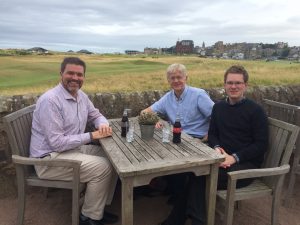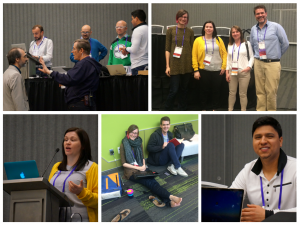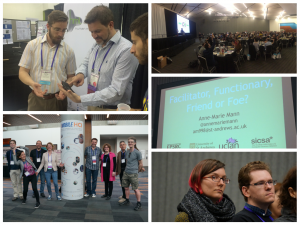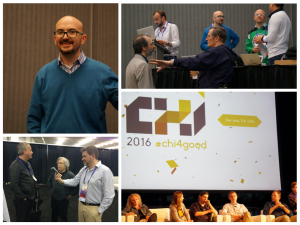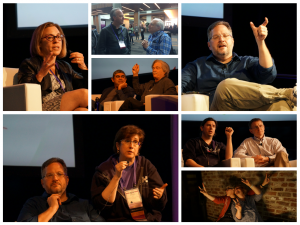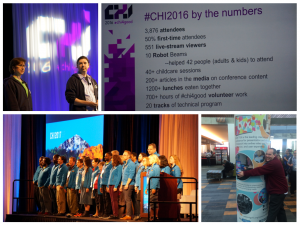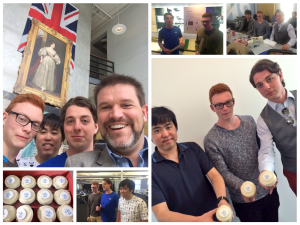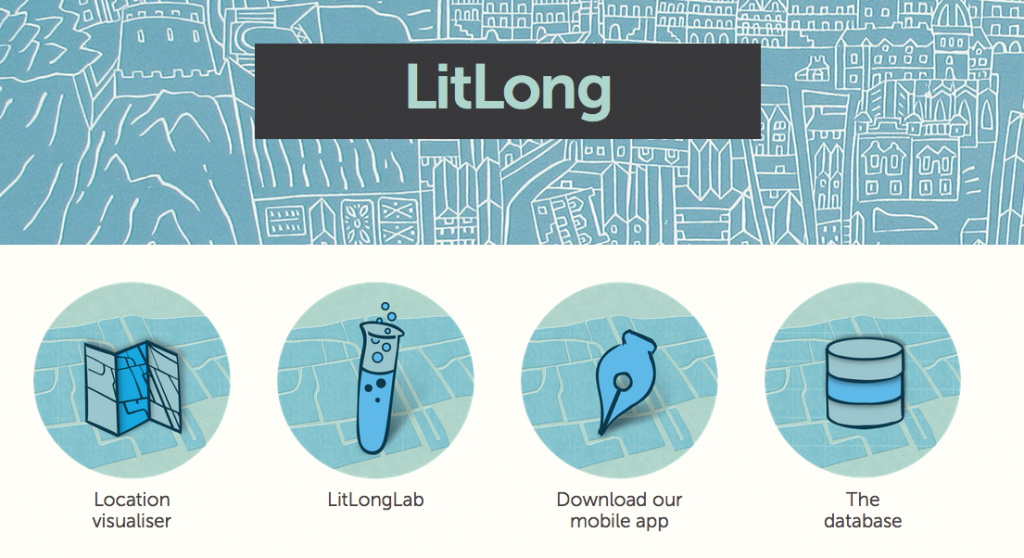Belated congratulations to Michael Mauderer, who successfully defended his thesis earlier this month. Micheal’s thesis, augmenting visual perception with gaze-contigent displays, was supervised by Dr Miguel Nacenta. Professor Aaron Quigley acted as internal examiner and Professor Hans Gellersen, from Lancaster University acted as external examiner.
SACHI
Deepview Project: Innovative GAZER Software
Congratulations to Dr Miguel Nacenta and Michael Mauderer on the success of Deepview and its subsequent application Gazer, an open source tool that provides functionality for showcasing light field images using gaze-contingent focus. The software, developed by SACHI, works in conjunction with eye tracking devices to allow photographers using light field cameras to discern images by automatically concentrating on objects using just their eyes.
Results from the project have been widely disseminated in the media and featured on a BBC click episode (20.56)
For more information and downloads visit the Gazer project section or github repository.
The project was funded through the European Union’s Marie Curie Program (CIG – 303780).
SACHI presence at CHI 2016
The SACHI group were well represented at CHI 2016 held in San Jose, California. The ACM CHI Conference on Human Factors in Computing Systems is the premier international conference of Human-Computer Interaction, and an exciting venue to discover, discuss and learn about the future of how people interact with technology.
SACHI presented five full papers, one note and a workshop paper, ran a successful workshop on Proxemic Mobile Collocated Interactions and designed many of the vibrant SIGCHI banners on display throughout the conference.
Well done to all concerned. SACHI group activities, conference keynote and plenary sessions are pictured below. CHI 2017 will be held in Denver, Colorado next year with a September deadline for papers and notes.
Images courtesy of Aaron Quigley
SACHI contributes to Google’s Project Soli
The SACHI group’s contribution to Project Soli was selected and featured in the official alpha developer video released by Google’s Advanced Technology and Projects group (ATAP), and has subsequently been shown on stage during the Google I/O ATAP 2016 session earlier in May.
The team systematically explored the Soli and developed machine learning techniques to train and classify objects. Achieving advanced interactions in real time, at this scale with consumer ready devices is an exciting development within the project. Read more about their research and Project Soli experience in “Object recognition with the Project Soli in St Andrews”.
The team consisted of Hui-Shyong Yeo (a PhD student in SACHI), Patrick Schrempf (a 2nd year CS student), Gergely Flamich (a 2nd year CS student), Dr David Harris-Birtill (a senior research fellow in SACHI) and Professor Aaron Quigley.
Elise van den Hoven : Materialising Memories: a design research programme to study everyday remembering
Abstract
Perhaps the term computer ‘memory’ has led people to believe that human memory has to be perfect and infallible. Many people worry when they realise they forget and some turn to recording and collecting as much as they can, e.g. photos or videos through life logging. Some people assume that by collecting they can avoid forgetting or at least have access to the information anytime later. And that is where they might be wrong. First of all, recordings are not equivalent to memories, and memories ‘can not be stored’. Secondly it has already been shown that people collect too much and organize too little for them to be able to find information later [1]. Thirdly, human memory works best when we forget… a lot.
What I want to talk about is my vision [2] that we can use design research to support human remembering by supporting our memory’s functions [3], which include a directive function (using the past to guide present and future thoughts and behaviours, e.g. solving problems), a self-representative function (creating a sense of self over time) and a social function (developing and nurturing relationships, through sharing of personal experiences). It is important to realise that in order to support these functions there is no need to improve our remembering capabilities, however it could benefit from the right type of support. Since remembering is a reconstructive process, individual memories are subject to change, continuously, and what someone experiences as a memory does not have to be the same as what happened or what other people remember from the experience.
Bits of information from the original experience can be used to stimulate and facilitate the reconstruction process. These so-called memory cues [4], which can be anything: from a photo, a song to a person or a location, are at the core of our research. We use a people-centred approach to study memory cues in everyday life, which informs the design of interactive systems that present these memory cues. Since these cues are often digital, while people prefer material objects [e.g. 5], we combine material and digital in our studies and designs.
- Whittaker, S., Bergman, O., and Clough, P. Easy on that trigger dad: a study of long term family photo retrieval. Personal and Ubiquitous Computing 14,1 (2010), 31-43.
- Hoven, E. van den. A future-proof past: Designing for remembering experiences. Memory Studies 7, 3 (2014), 373-387.
- Bluck, S., Alea, N., Habermas, T., and Rubin, D. C. A tale of three functions: The self–reported uses of autobiographical memory. Social Cognition 23, 1 (2005), 91-117.
- Hoven, E. van den, and Eggen, B. The Cue is Key: Design for Real-Life Remembering. Zeitschrift für Psychologie 222, 2 (2014), 110-117.
- Golsteijn, C., Hoven, E. van den, Frohlich, D., and Sellen, A. Towards a More Cherishable Digital Object. In Proc. DIS 2012, ACM Press (2012), 655-664.
Bio
Professor Dr Elise van den Hoven MTD is full Professor in the School of Software, Faculty of Engineering and Information Technology, University of Technology Sydney (UTS) and part-time Associate Professor in the Department of Industrial Design, Eindhoven University of Technology (TU/e). She has two honorary appointments: Honorary Senior Research Fellow in Duncan of Jordanstone College of Art and Design, University of Dundee and Associate Investigator with the Australian Research Council’s Centre of Excellence in Cognition and its Disorders.
Her research interests span different disciplines, including human-computer interaction, design and psychology, including people-centred design, designing interactive systems, physical interaction and supporting human remembering.
Professor Van den Hoven leads the international research programme Materialising Memories, a collaboration between UTS, TU/e and the University of Dundee, which uses a design research approach to study people in their everyday remembering activities in order to come up with ways to support them.
www.elisevandenhoven.com
www.materialisingmemories.com
Event details
- When: 20th April 2016 14:00 - 15:00
- Where: Cole 1.33a
- Series: School Seminar Series
- Format: Seminar
Daniel Archambault : Effective Visualisation of Static and Dynamic Graphs
Abstract
Visualising dynamic graphs is important for many application areas. For social media networks, they can help us understand the interaction and interests of users online. In biology, they can illustrate the interactions between genes and biological processes. Understanding and designing effective visualisation methods for dynamic network data is fundamental to these areas as well as many others. In this talk, we focus on the effective presentation of dynamic networks. In particular, we summarise recent results on dynamic graph visualisation with respect to animation (presentation of interactive movies of the data), small multiples (presenting the data through several linked windows like a comic book), and drawing stability (the visual stability of the data presentation). We conclude with some recent work on scalable graph visualisation and in the visualisation of sets and their intersections.
Biography
Daniel Archambault has been working in the field of information visualization for ten years. His work in this area has focused on the development and evaluation of techniques for visualizing dynamic networks and scalable graph visualizations. His research has been been applied to many areas outside of computer science, including the digital humanities, biology, networking, sociology, and social media analysis.
Event details
- When: 12th April 2016 14:00 - 15:00
- Where: Cole 1.33a
- Series: School Seminar Series
- Format: Seminar
Keith Cheverst: Investigating the Shared Curation of Locative Media relating to the Local History of a Rural Community
Abstract
In this talk I will present experiences and insights from our studies involving locative media, local history and community. Our work in the village of Wray has involved the longitudinal and ‘in the wild’ deployment of ‘digital noticeboard’ displays (conceived as technology probes) that support the sharing of photos/images. A significant portion of the submitted photo content relates to Wray’s local history and features of Wray’s landscape. Residents of the village have helped shape the system through involvement in co-design workshops. A key motivation of our current studies (as part of the SHARC project) is to explore issues around the co-curation of locative media experiences. A field trial (involving both residents and visitors) and a design workshop revealed both opportunities and challenges for the co-curation approach.
Bio
 Dr Keith Cheverst is a Reader in HCI at Lancaster University where he obtained his PhD in 1999. Keith has also held the position of visiting scientist at Newcastle University’s Culture Lab, at Microsoft Research, Cambridge (working with the Socio-Digital systems group), and at the University of Melbourne (Department of Computing and Information Systems).
Dr Keith Cheverst is a Reader in HCI at Lancaster University where he obtained his PhD in 1999. Keith has also held the position of visiting scientist at Newcastle University’s Culture Lab, at Microsoft Research, Cambridge (working with the Socio-Digital systems group), and at the University of Melbourne (Department of Computing and Information Systems).
Keith’s primary research focus is in exploring the obdurate problems associated with the user-centered design of interactive systems in complex or semi-wild settings and the deployment and longitudinal study of these systems in order to gain insights into issues of user adoption and appropriation. He is particularly interested in the design interactive systems that feature locative media and associated mobile/pervasive technologies
Event details
- When: 5th April 2016 14:00 - 15:00
- Where: Cole 1.33a
- Series: School Seminar Series
- Format: Seminar
Palimpsest recognised by British Library Labs
A new annual competition set up to identify outstanding and innovative work, created using the British Library’s digital collections and content, has recognised Palimpsest. The 2015 British Library Labs Awards honoured projects within three key categories: Research, Creative/Artistic and Entrepreneurship. Palimpsest: Telling Edinburgh’s Stories with Maps, was runner up in the Research category.
Congratulations to Uta, David and Aaron on the continued success of Palimpsest.
IEEE talks: JEEVES and the Speculative W@nderverse
In October 2015 we attended two IEEE conferences in the USA. Daniel Rough presented a full paper at the IEEE Symposium on Visual Languages and Human-Centric Computing, October 18–22, in Atlanta, Georgia. Uta Hinrichs presented a full paper at the IEEE Information Visualization (InfoVis) conference as part of VizWeek, October 25-30 in Chicago, Illinois. You can find details of these and all our papers on the publications page.
On November 10th, Daniel and Uta will reprise their talks here in St Andrews and everyone is welcome to attend. You can find the details for the two talks below along with links to the papers via the University of St Andrews research portal.
Talk 1 by Daniel Rough
Title: Jeeves – A Visual Programming Environment for Mobile Experience Sampling
Authors: Rough, D and Quigley, A.
Abstract: The Experience Sampling Method (ESM) captures participants’ thoughts and feelings in their everyday environments. Mobile and wearable technologies afford us opportunities to reach people using ESM in varying contexts. However, a lack of programming knowledge often hinders researchers in creating ESM applications. In practice, they rely on specialised tools for app creation. Our initial review of these tools indicates that most are expensive commercial services, and none utilise the full potential of sensors for creating context-aware applications.
We present “Jeeves”, a visual language to facilitate ESM application creation. Inspired by successful visual languages in literature, our block-based notation enables researchers to visually construct ESM study specifications. We demonstrate its applicability by replicating existing ESM studies found in medical and psychology literature. Our preliminary study with 20 participants demonstrates that both non-programmers and programmers are able to successfully utilise Jeeves. We discuss future work in extending Jeeves with alternative mobile technologies.
Paper details from the St Andrews Research Portal: Rough, DJ & Quigley, AJ 2015, ‘ Jeeves – a visual programming environment for mobile experience sampling ‘, IEEE Symposium on Visual Languages and Human-Centric Computing (VL/HCC), Atlanta, United States
Talk 2 by Uta Hinrichs
Title: Speculative Practices: Utilizing InfoVis to Explore Untapped Literary Collections
Hinrichs, U., Forlini, S. ; Moynihan, B.
In this paper we exemplify how information visualization supports speculative thinking, hypotheses testing, and preliminary interpretation processes as part of literary research. While InfoVis has become a buzz topic in the digital humanities, skepticism remains about how effectively it integrates into and expands on traditional humanities research approaches. From an InfoVis perspective, we lack case studies that show the specific design challenges that make literary studies and humanities research at large a unique application area for information visualization. We examine these questions through our case study of the Speculative W@nderverse, a visualization tool that was designed to enable the analysis and exploration of an untapped literary collection consisting of thousands of science fiction short stories. We present the results of two empirical studies that involved general-interest readers and literary scholars who used the evolving visualization prototype as part of their research for over a year. Our findings suggest a design space for visualizing literary collections that is defined by (1) their academic and public relevance, (2) the tension between qualitative vs. quantitative methods of interpretation, (3) result- vs. process-driven approaches to InfoVis, and (4) the unique material and visual qualities of cultural collections. Through the Speculative W@nderverse we demonstrate how visualization can bridge these sometimes contradictory perspectives by cultivating curiosity and providing entry points into literary collections while, at the same time, supporting multiple aspects of humanities research processes.
Published in:
IEEE Transactions on Visualization and Computer Graphics, (Vol:22, Issue: 1 ) Page(s): 429 – 438
ISSN : 1077-2626
DOI: 10.1109/TVCG.2015.2467452
Paper details from the St Andrews Research Portal:
Hinrichs, U, Forlini, S & Moynihan, B 2015, ‘ Speculative practices: utilizing InfoVis to explore untapped literary collections ‘ IEEE Transactions on Visualization and Computer Graphics .
Event details
- When: 10th November 2015 14:00 - 15:00
- Where: Cole 1.33a
- Format: Talk
Seminar: ‘Disrupting trillion dollar industries using low power wireless sensor networks’ by Raphael Scheps and Gideon Farrell
Abstract:
Some of the world’s most important industries are intrinsically grounded in the physical world, yet their interaction with it is still almost completely manual. Converge is a young startup, forged in the fires of Entrepreneurs First, that is building wireless, distributed sensor networks to revolutionise how these industries operate. We (Raph and Gideon, founders) will talk about our tech (and what makes it a fun challenge to build), the difficulties of working in enormous and complex industries and our first 10 months as a company.
Bio:
Gideon and Raphael co-founded Converge to deal with the huge amounts of data that will be produced by connected devices. Two Physicists from Cambridge, they are obsessed with instrumenting the world with connected sensors to drive a smarter physical environment. Gideon read Astrophysics at the University of Cambridge, and obtained his M.Sci with a thesis on Solar Jets. He has been writing software for over 10 years, working for companies such as Primary Energy Research and Softeam Cadextan. He worked on the first generation of IoT connected sensors at the Georgia Tech Research Institute (The WISP project) in 2009. Raphael read Theoretical Physics, obtaining an M.Math with a thesis on String Theory and Quantum Gravity. He has worked on high speed interconnect within the hardware engineering team at Mellanox as well as the experimental astrophysics team at the Weizmann Institute of Science. He was Vice President at Cambridge University Entrepreneurs, the oldest student entrepreneurship society in Europe. They both met at Cambridge five years ago and started Converge in 2014.
This seminar is part of our ongoing school series. To see all our upcoming seminar follow this link: here.
Event details
- When: 22nd September 2015 14:00 - 15:00
- Where: Cole 1.33a
- Series: School Seminar Series
- Format: Seminar


